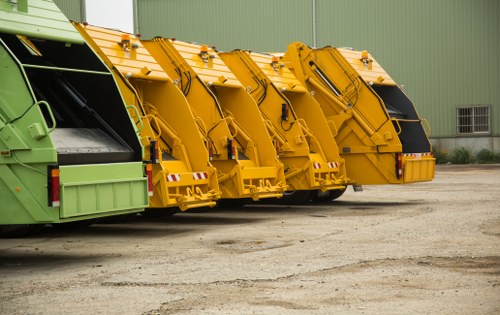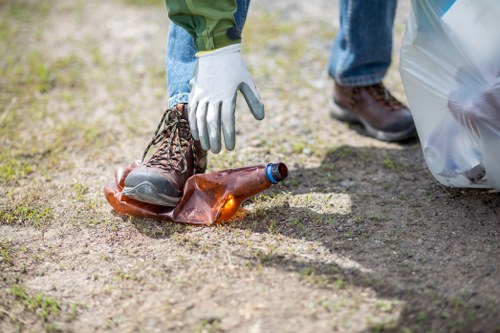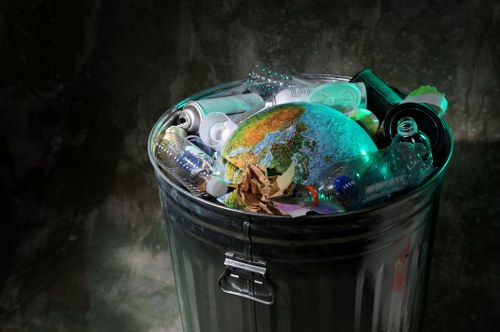Bed Disposal in White Goods Recycle

Understanding Bed Disposal
Disposing of an old bed can be a daunting task, especially when considering the environmental impact. Beds, being bulky items, require special attention to ensure they are recycled or disposed of responsibly. Proper bed disposal not only helps in reducing landfill waste but also promotes recycling practices that benefit the environment.
When it comes to bed disposal, it's essential to understand the various components that make up a bed. From the frame and mattress to the springs and fabric, each part has different recycling or disposal methods. By breaking down these components, we can ensure that each part is handled appropriately, minimizing environmental harm.
White goods recycling typically refers to the recycling of large household appliances like refrigerators, washing machines, and dryers. However, bed disposal can also fall under this category when considering the materials involved. Proper disposal of beds within white goods recycling programs ensures that valuable materials are recovered and reused.

Why Recycle Your Bed?
Recycling your bed offers several benefits. Firstly, it reduces the amount of waste sent to landfills, helping to conserve space and prevent environmental degradation. Secondly, recycling allows valuable materials such as metal, wood, and fabric to be repurposed, reducing the need for new raw materials.
Additionally, recycling your bed can contribute to energy conservation. Manufacturing new bed components from recycled materials typically requires less energy compared to producing them from scratch. This reduction in energy consumption leads to lower carbon emissions, benefiting the environment.
Moreover, recycling your bed promotes a circular economy where products are reused and recycled, creating a sustainable cycle that supports long-term environmental health. By choosing to recycle, you are making a positive impact on the planet and supporting eco-friendly practices.

Components of a Bed and Their Recycling Process
Bed Frame
The bed frame is usually made of wood or metal. Wooden frames can be refurbished or repurposed into other furniture items. Metal frames are highly recyclable and can be melted down to create new metal products.
Mattress
Mattresses contain various materials, including foam, springs, and fabric. Specialized recycling facilities can separate these components, allowing each material to be processed appropriately. Foam can be recycled into carpet padding or new mattresses, while metal springs can be recycled as scrap metal.
Bedding and Mattresses
Many bedding materials, such as fabric and foam, are recyclable. It's essential to disassemble the mattress and bedding to ensure that each material is processed correctly. Some recycling programs accept entire mattresses, while others require you to separate the components.

Steps to Dispose of Your Bed Responsibly
Disposing of a bed responsibly involves several steps to ensure that each component is recycled or disposed of properly. Here's a comprehensive guide to help you through the process:
- Assess the Condition: Determine if the bed or its components are still usable. If they are in good condition, consider donating or selling them.
- Contact Local Recycling Centers: Reach out to recycling facilities that accept beds or specific bed components.
- Disassemble the Bed: Break down the bed into its individual parts, such as the frame, mattress, and headboard.
- Separate Materials: Sort the materials for recycling, ensuring that metals, wood, and textiles are separated.
- Arrange for Pickup or Drop-off: Coordinate with the recycling center to either drop off the materials or arrange for a pickup.
- Follow Local Regulations: Ensure that you adhere to your area's disposal and recycling regulations.

Choosing the Right White Goods Recycle Service
Selecting a reliable white goods recycling service is crucial for effective bed disposal. Look for services that specialize in large item recycling and have a good reputation for environmentally friendly practices.
Ensure that the recycling service is licensed and adheres to local regulations. A reputable service will provide transparent information about their recycling processes and ensure that materials are handled responsibly.
Additionally, consider the convenience and cost of the service. Some providers offer free pickup, while others may charge a fee based on the size and weight of the items. Compare different services to find one that meets your needs and budget.
Environmental Impact of Improper Bed Disposal
Improper disposal of beds can have severe environmental consequences. Beds sent to landfills contribute to the growing waste problem, taking up valuable space and releasing harmful substances as they decompose.
Mattresses, in particular, pose significant challenges due to their complex composition. The chemicals and materials used in mattresses can leach into the soil and water, causing pollution and harming wildlife.
By recycling your bed, you help mitigate these negative impacts, promoting a healthier environment and supporting sustainable waste management practices.
Benefits of Professional Bed Disposal Services
Utilizing professional bed disposal services offers numerous advantages. These services have the expertise and equipment necessary to handle large and heavy items safely and efficiently.
Professional services ensure that beds are disassembled correctly, and materials are sorted for recycling. This meticulous process maximizes the recycling potential of each component, reducing waste and conserving resources.
Furthermore, professional disposal services save you time and effort. Instead of managing the disposal process yourself, which can be time-consuming and physically demanding, professionals handle everything, providing a hassle-free experience.
Cost-Effective Disposal Solutions
While some might perceive recycling services as an added expense, it can be cost-effective in the long run. Many recycling centers offer free pickup services, and some communities provide subsidized disposal programs.
In addition, recycling materials can generate revenue for recycling centers, which may offset some of the costs associated with disposal. This can make professional bed disposal more affordable than expected.
Moreover, the environmental benefits of recycling translate into long-term economic savings by reducing the need for new raw materials and minimizing environmental cleanup costs.
DIY Bed Disposal Tips
If you prefer to handle bed disposal yourself, here are some tips to ensure you do it responsibly:
- Leverage Community Programs: Many communities offer bulk waste pickup days or special recycling events where you can dispose of large items like beds.
- Repurpose Materials: Get creative by repurposing parts of your bed. Wooden frames can be used in DIY projects, and metal parts can be reused in other applications.
- Donate Usable Items: If your bed is still in good condition, consider donating it to charities or second-hand stores. This extends the life of the bed and benefits those in need.
- Check for Manufacturer Take-Back Programs: Some bed manufacturers offer take-back programs where they handle the disposal or recycling of their products.
Safety Precautions During Disposal
Disposing of a bed involves handling heavy and potentially hazardous materials. It's crucial to take safety precautions to prevent injuries and accidents.
Wear appropriate protective gear, such as gloves and sturdy footwear, to safeguard against sharp edges and heavy lifting. Use proper tools to disassemble the bed, ensuring that you handle each component carefully.
When transporting the bed, secure it properly in your vehicle to prevent shifting and potential damage. If the bed is too heavy or cumbersome, consider enlisting help or hiring professionals to assist with the disposal process.
Legal Considerations for Bed Disposal
Different regions have specific regulations regarding the disposal and recycling of large household items. It's essential to familiarize yourself with these laws to ensure compliance.
Non-compliance can result in fines and penalties, so understanding local guidelines is crucial. Some areas may require you to schedule a pickup in advance, while others might have designated drop-off locations.
Additionally, certain materials found in beds, such as mattresses treated with flame retardants, may have special disposal requirements due to their environmental impact.
Eco-Friendly Bed Disposal Practices
Adopting eco-friendly practices when disposing of your bed can significantly reduce your environmental footprint. Opt for recycling over landfill disposal to ensure that materials are reused effectively.
Choose recycling services that prioritize sustainable practices, such as using energy-efficient processes and minimizing waste. Supporting such services encourages the industry to adopt more environmentally responsible methods.
Furthermore, consider the lifecycle of your bed when purchasing a new one. Selecting products made from sustainable materials and those designed for easy disassembly can facilitate future recycling efforts.
Innovations in Bed Recycling
The recycling industry is continually evolving, with new technologies enhancing the bed recycling process. Advanced machinery can now more efficiently separate and process the various materials found in beds, increasing the rate of material recovery.
Innovative techniques, such as chemical recycling, allow for the breakdown of complex materials into their basic components, which can then be reused in manufacturing new products. This not only improves recycling efficiency but also expands the range of materials that can be recycled.
Moreover, research is being conducted into sustainable materials that are easier to recycle, reducing the environmental impact from the outset. These innovations promise a more sustainable future for bed disposal and recycling.
Case Studies: Successful Bed Recycling Programs
Several communities have implemented successful bed recycling programs that can serve as models for others. These programs often involve partnerships between local governments, recycling centers, and non-profit organizations to facilitate the responsible disposal of beds.
For example, GreenRecycle, a community-based initiative, offers free mattress pickup and ensures that all materials are recycled appropriately. Their program has significantly reduced landfill waste and provided materials for new products.
Another example is the EcoBeds program, which collaborates with manufacturers to create a closed-loop system where old beds are returned and recycled into new ones. This approach not only recycles materials but also promotes sustainable manufacturing practices.
Future Trends in Bed Disposal and Recycling
The future of bed disposal and recycling looks promising with advancements in technology and increased environmental awareness. Trends indicate a shift towards more sustainable materials and designs that facilitate easier recycling.
Manufacturers are exploring eco-friendly materials that are both durable and easier to recycle, reducing the environmental impact of new beds. Additionally, modular bed designs are becoming more popular, allowing for individual components to be replaced or recycled without discarding the entire bed.
Furthermore, the integration of smart technologies in recycling facilities is enhancing the efficiency and effectiveness of the recycling process. Automation and data analytics are streamlining operations, leading to higher rates of material recovery and reduced processing times.
How You Can Contribute
Every individual can play a role in promoting responsible bed disposal and recycling. By choosing to recycle your bed, you contribute to a larger movement towards sustainability and environmental preservation.
Educate yourself and others about the importance of recycling and the impact of improper disposal. Share information about local recycling programs and encourage friends and family to participate.
Additionally, support businesses and services that prioritize environmentally friendly practices. Your consumer choices can drive the market towards more sustainable options, fostering a culture of recycling and conservation.
Conclusion
Proper bed disposal in white goods recycle is a crucial aspect of sustainable living. By understanding the components of your bed and the available recycling options, you can dispose of your bed responsibly, minimizing environmental impact.
Whether you choose to utilize professional disposal services or handle the process yourself, the key is to ensure that each component is recycled or repurposed appropriately. This not only reduces waste but also supports the conservation of valuable resources.
Embrace eco-friendly disposal practices and contribute to a healthier planet. Contact us today to learn more about our bed recycling services and take the first step towards responsible disposal.